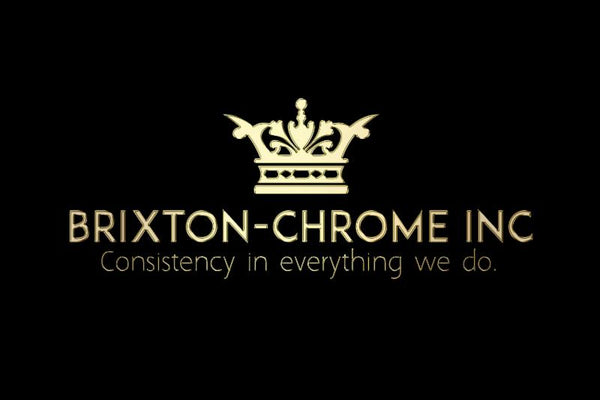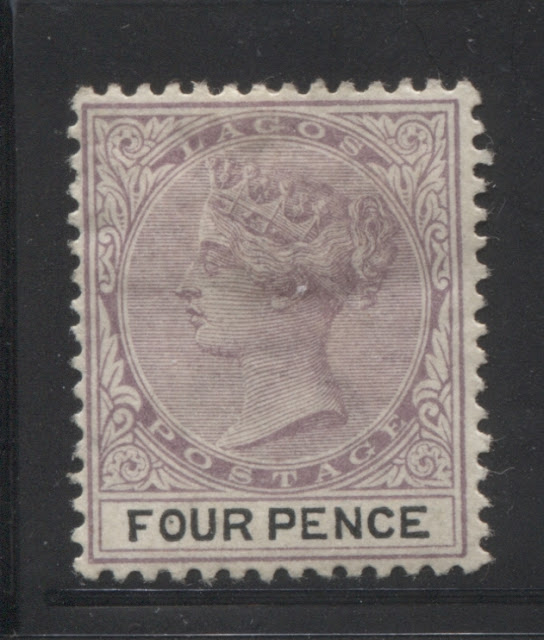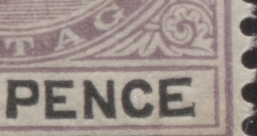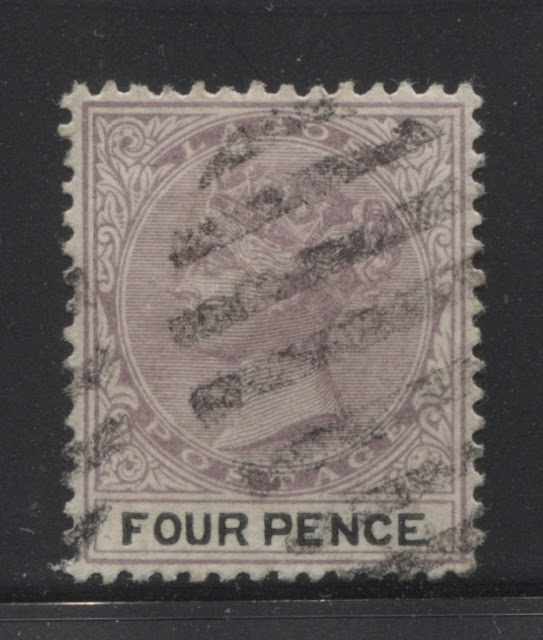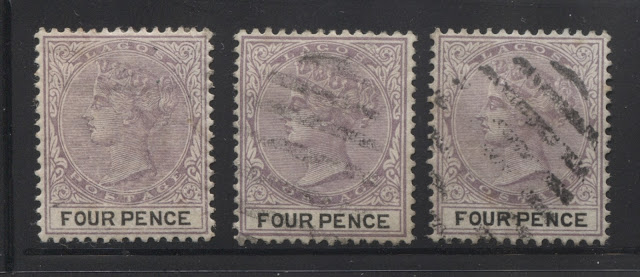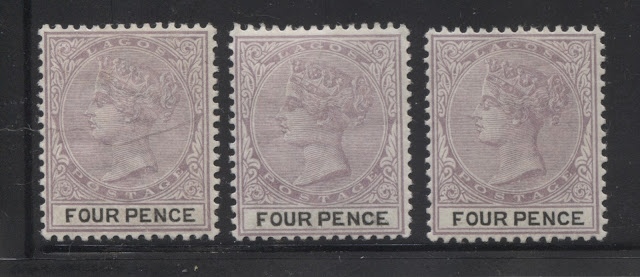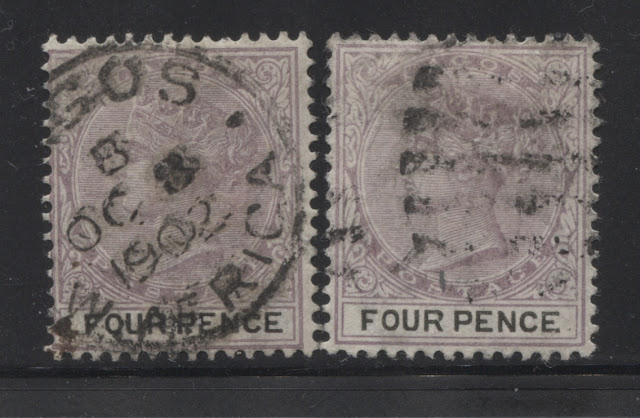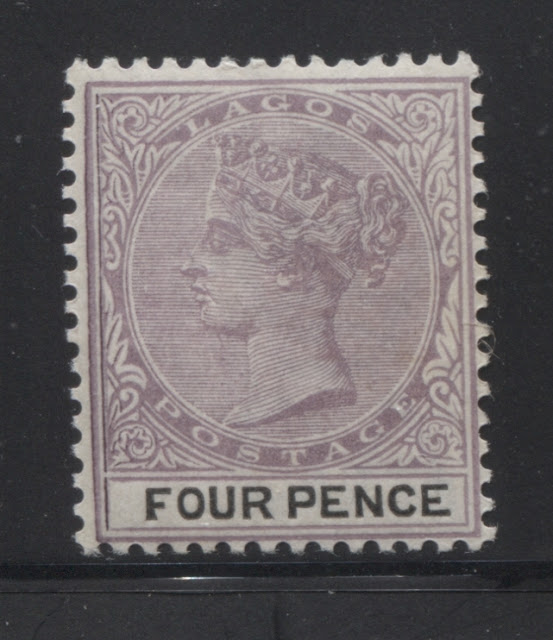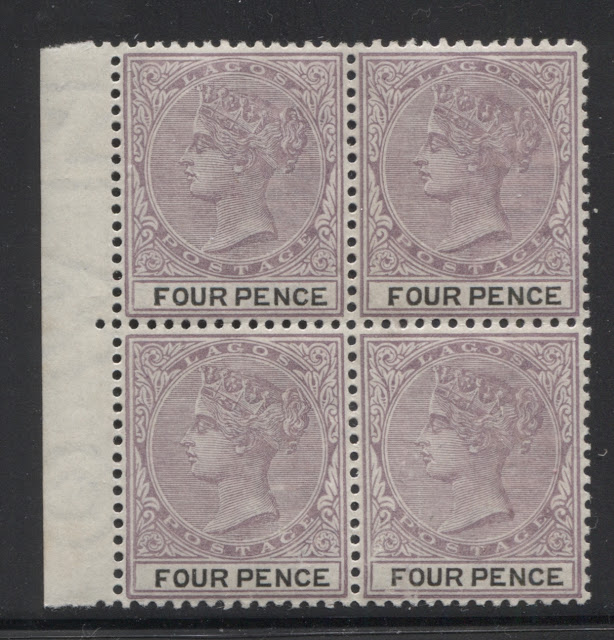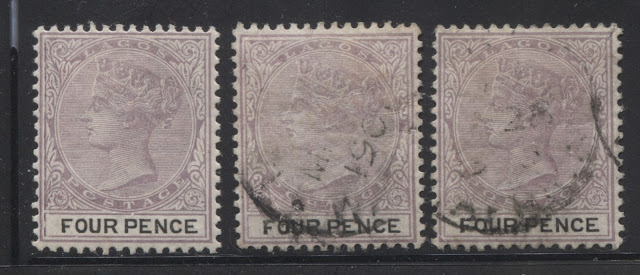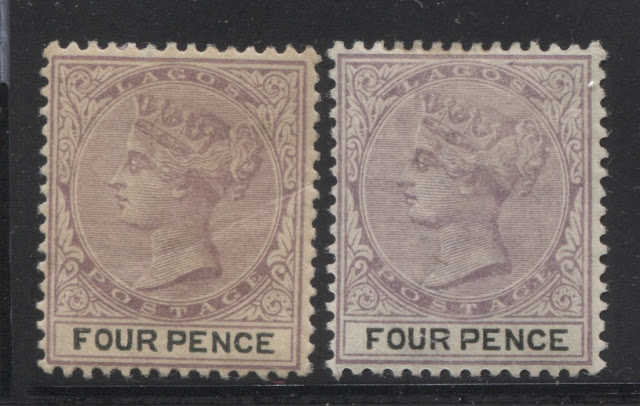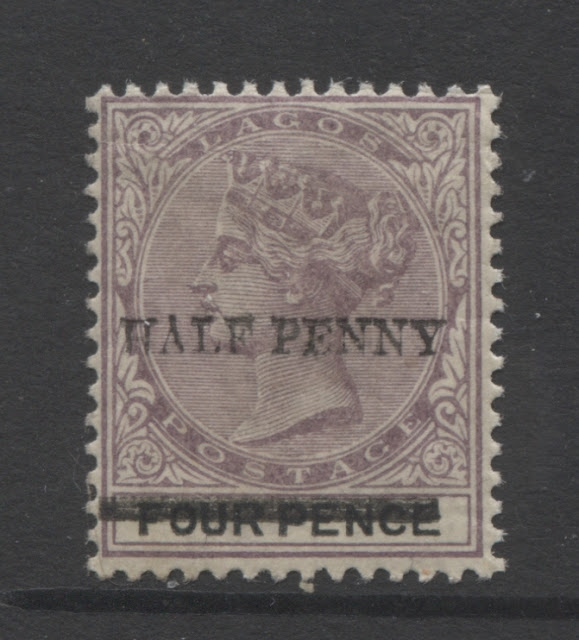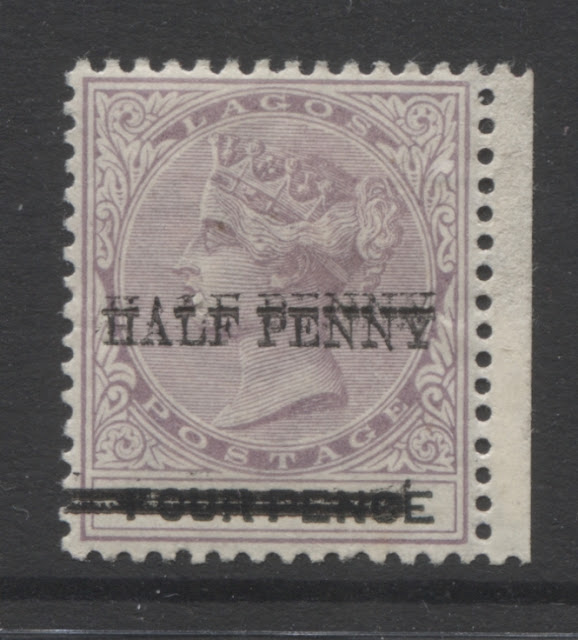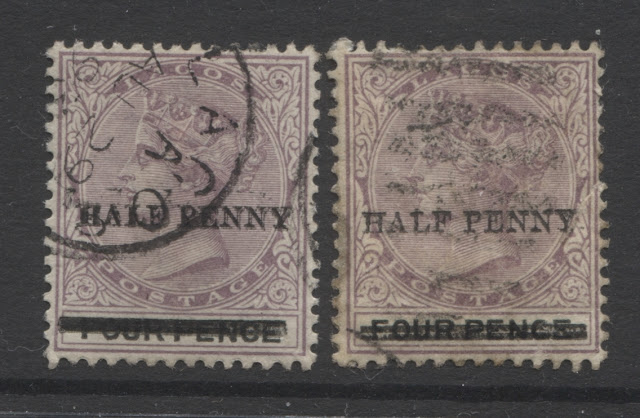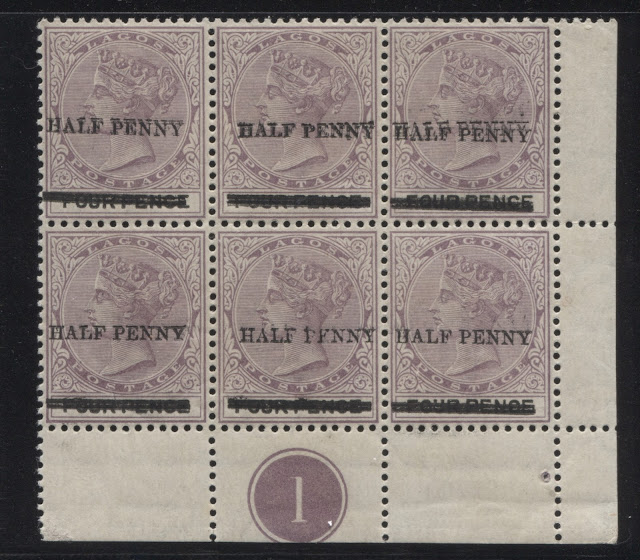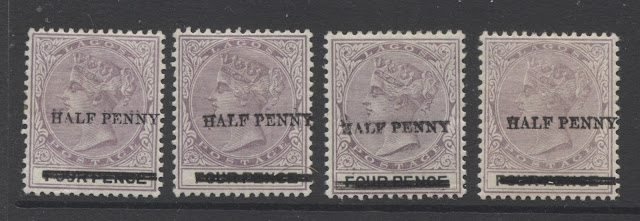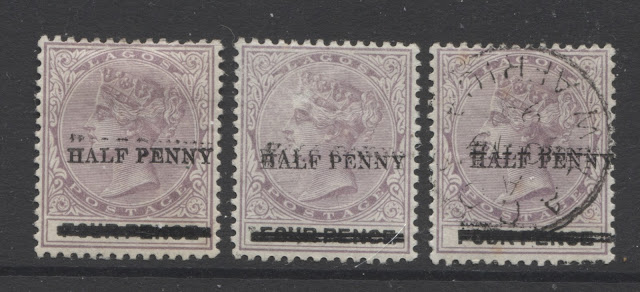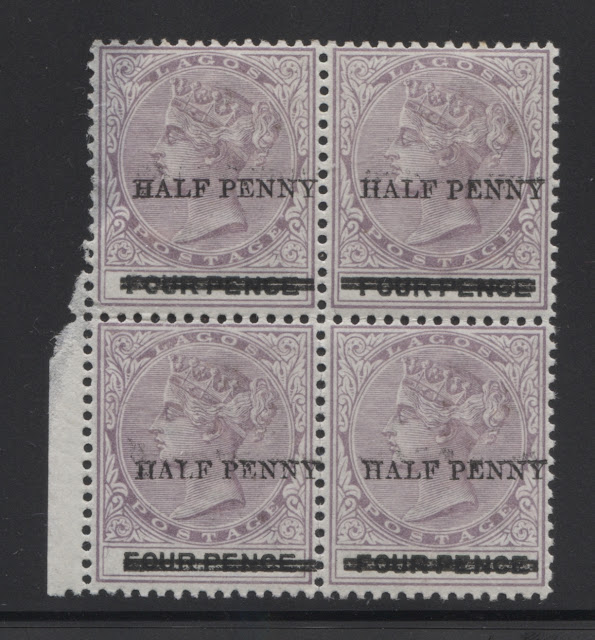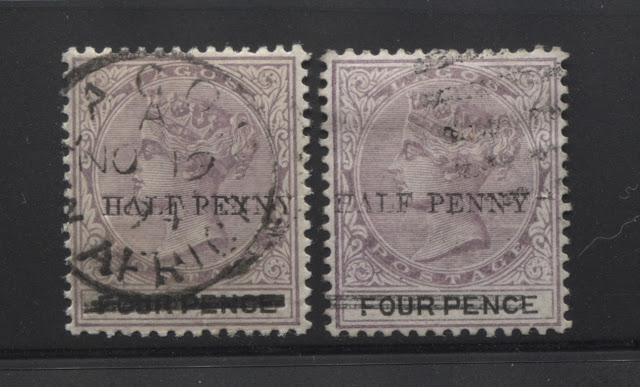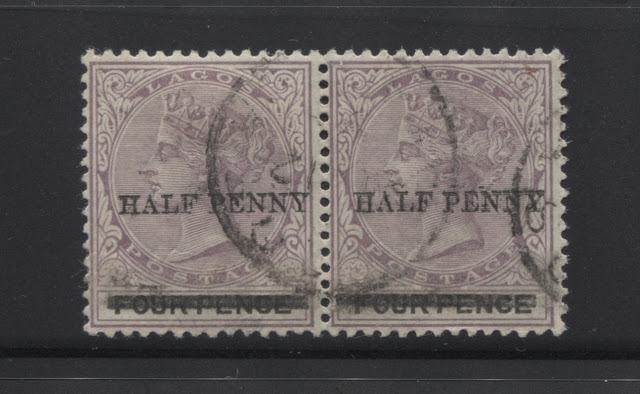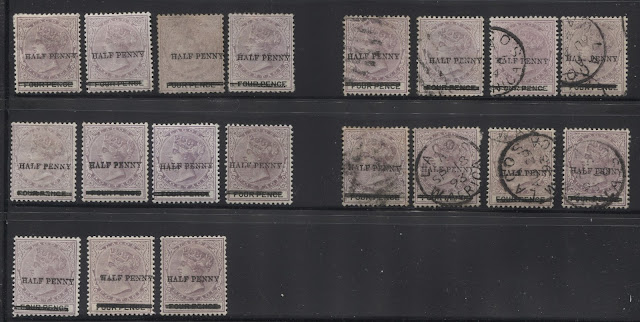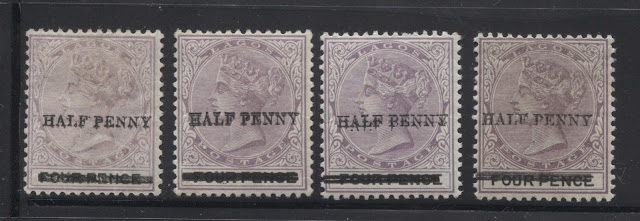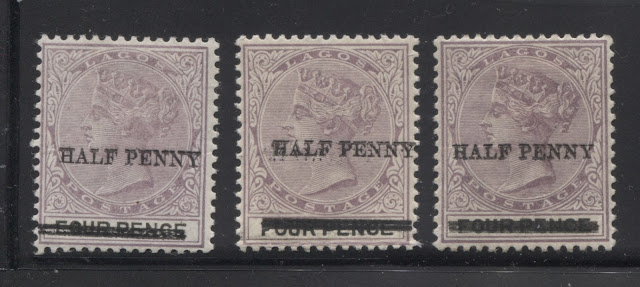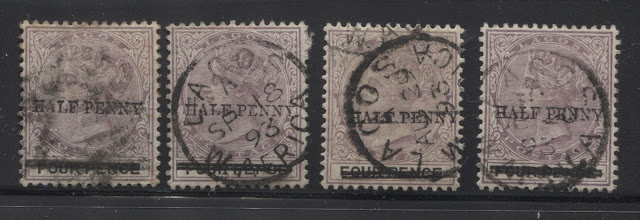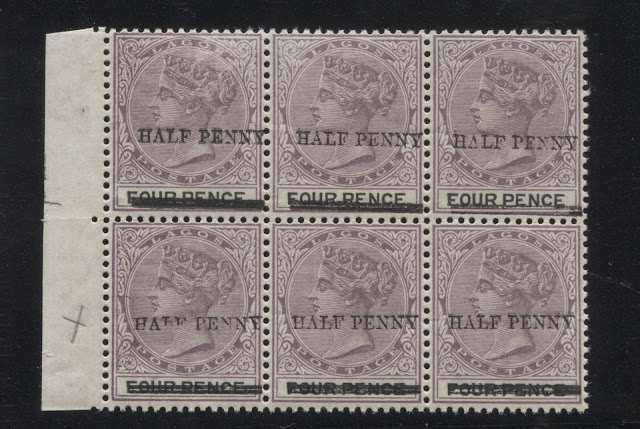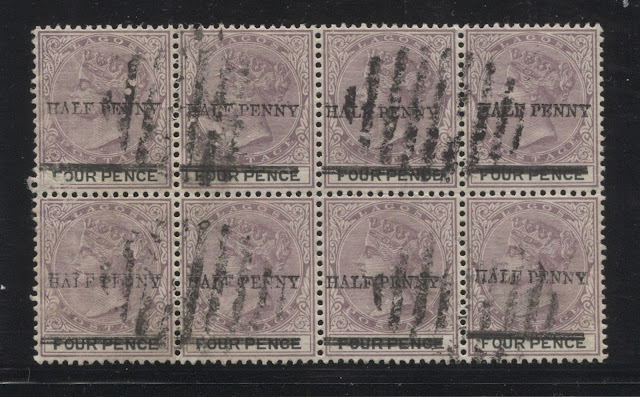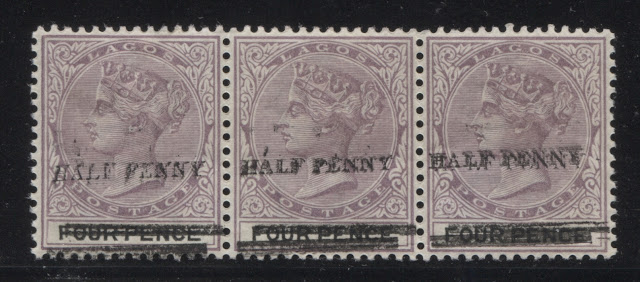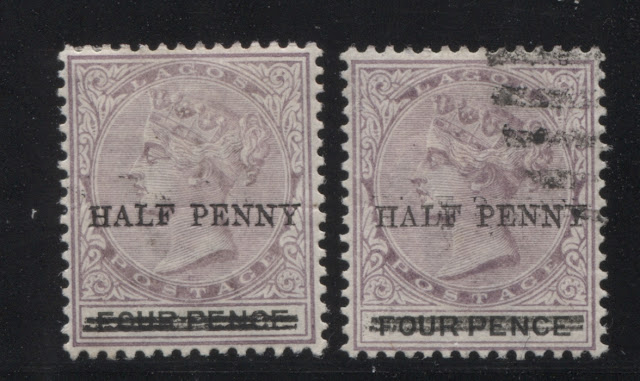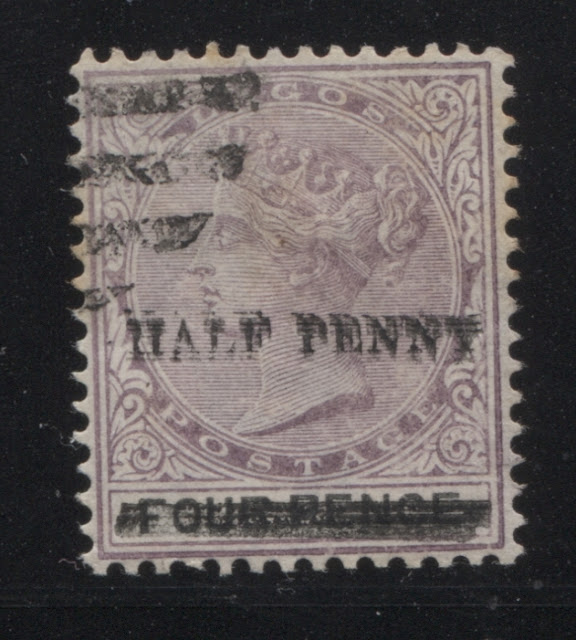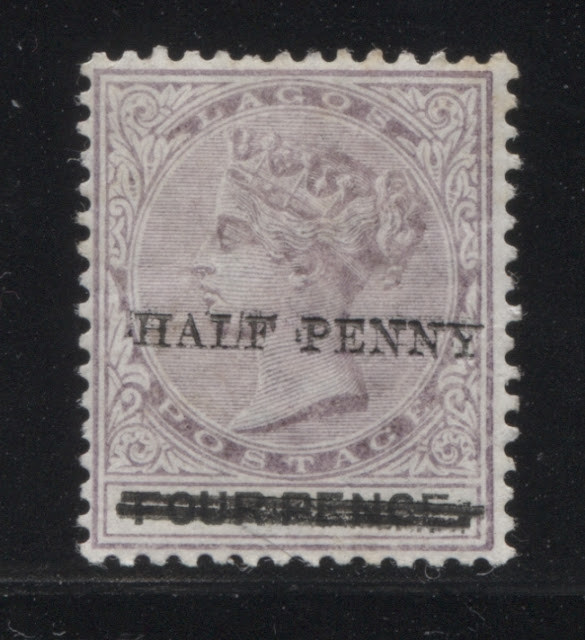In the last five posts I have identified up to 56 potential printings of the 4d lilac and black Queen Victoria Keyplate stamp. At this point what I have identified as printings 32 through 39 needs to be checked against the other printings 1-31 that I had already identified to ensure that they are not actually part of those printings. Secondly, they need to be compared to the surcharged stamps that I was not yet able to identify as to printing to see if they match any of those. Finally, I need to check the remaining unidentified surcharged stamps against printings 40-56 to see if they match any of those. Once all this is done, I can conclude that any remaining surcharged stamps that have not yet been assigned to printings represent completely separate printings. The first shipments of this stamp were sent to Lagos in March 1887, while the last were sent in August 1901. There are 15 full years in that period if you count both 1887 and 1901, and stamps were sent on a quarterly basis. Thus the absolute maximum number of sendings, assuming that a quantity of 4d stamps was always included with every shipment is 61. So there could be up to 61 printings of this stamp. Thus it is possible that every group that I have identified represents a separate printing.
I will start this post by re-producing the portion of last week's post dealing with printings 32-39 and noting how these printings compare to both the unoverprinted stamps from printings 1-31 and the surcharges.
The colour of this printing is closest to Gibbons's lilac, but is just a bit paler and duller. It has a bluish undertone, so it is not a pale version of the reddish lilac, and it does not have the blackish undertone that the slate lilac has, so I would call this a dull lilac. I have three mint examples as shown above, and two used examples as shown below:
I will start this post by re-producing the portion of last week's post dealing with printings 32-39 and noting how these printings compare to both the unoverprinted stamps from printings 1-31 and the surcharges.
Thirty Second Printing (Now Determined to be Another Example of the Thirteenth Printing)
The colour of this printing is a perfect match to Gibbons's reddish lilac. I have only the mint example shown above and no used examples.
Upon comparison of this stamp with the others, I can see that is is very similar to the fifth printing, but is an exact match with the thirteenth printing. While doing the comparison, another look at the first stamp of of the thirteenth printing revealed another potential constant plate flaw: A deformed last "E" in "Pence". Normally, the bars of the E are thin and uniform as shown above. But on this stamp, the lower bar of the last "E" of "Pence" gets thicker toward the end and has a spur on the end. The enlarged scan below shows this clearly:
Thirty Third Printing (Now Determined to be the Thirty Second Printing)
This printing is closest to Gibbons's reddish lilac also, but the colour is paler and milkier. I have only a single used example shown above, which is cancelled with a clear strike of an 8-bar oval obliterator.
There is some similarity between this and printings 9 & 10, but this one is a little rosier. So I would propose that this is indeed a separate printing.
Thirty Fourth Printing (Now determined to be the Thirty Third Printing)
The colour of these three stamps is closest to Gibbons's slate lilac, but is quite a bit paler. However it lacks the reddish tone of the reddish lilac. I have a single mint example, as shown on the left, and two used examples. Both of these are cancelled with a clear strike of a 9-bar oval obliterator.
This printing is very close in shade to the seventh printing, but is just different enough that I am prepared to consider this as a separate printing.
Thirty Fifth Printing (Now Determined to be the Twenty Seventh Printing)
This printing is closest to Gibbons's reddish lilac, but the colour is deeper than both the Gibbons swatch, at the stamp of the thirty second printing above. I have one single mint example shown at the left and two used examples. The middle stamp is cancelled with some kind of oval obliterator, though it is hard to tell whether or not it is an 8 bar or 9 bar obliterator. The stamp on the right is cancelled with the larger, wider Lagos CDS that was in use after 1903. This particular example is dated 1904, which suggests it is a very late use of an earlier printing that took place just before all unsold remainders were rounded up and sent back to London for destruction.
The shade of these stamps is an exact match to the twenty seventh printing that I had already identified earlier. The plate characteristics were also a match. Consequently, I consider these to be more examples of the twenty-seventh printing.
Thirty Sixth Printing (Now determined to be the Thirty Fourth Printing)
The colour of this printing is closest to Gibbons's lilac, but is just a bit paler and duller. It has a bluish undertone, so it is not a pale version of the reddish lilac, and it does not have the blackish undertone that the slate lilac has, so I would call this a dull lilac. I have three mint examples as shown above, and two used examples as shown below:
The stamp on the right is cancelled with an oval obliterator, most likely an 8-bar oval. The left stamp is canceled with an October 8, 1902 Lagos CDS, which again would suggest a very late usage of an earlier printing, which is not unusual as we have seen.
The shade of this printing is close to the twenty fourth printing, but these stamps are just a touch more bluish. So I consider this to be a separate printing.
Thirty Seventh Printing (Now Determined to be the Thirty Fifth Printing)
The colour of this printing is closest to the reddish lilac also, but the colour is just slightly duller than the Gibbons reddish lilac swatch. However, the overall tone is a perfect match. I have a single mint example as shown above, five used examples as shown below, and a mint marginal block shown below that:
All of the used examples shown here, except the second one are cancelled with either 8 or 9 bar oval obliterators. It is difficult to make them out exactly, but the first and fourth stamps appear to be 8-bars, while the third and fifth appear to be 9-bar obliterators. The second stamp is cancelled with an indistinct CDS, most likely Lagos.
The mint block of four, shown below, from the left side of the sheet, showing the Crown Agent's watermark in the left selvage, matches both the shade and plate characteristics of the stamps in this group. Therefore, I have ascribed this block to the thirty seventh printing.
The first used stamp in this group shows a clear break in the outer circular frame under the "A" of "Postage". This break is likely constant, though further research would be required to prove this. Although the stamp does have some minor surface scuffing, there is no trace of any colour in the area around the break, nor is there any apparent surface damage to the paper where the break is seen. This suggests that it is a genuine variety and not the result of a scuff:
The shade of these stamps does not quite match any of the printings already already identified. Therefore I have classified these as a separate printing.
Thirty Eighth Printing (Now Determined to be the Twenty Sixth Printing)
The colour of this printing is again closest to the reddish lilac, but is duller. Therefore I would call this dull reddish lilac. I have one single mint example as shown at left, and two used used examples, both cancelled with Lagos CDS's. The middle stamp is dated sometime in May 1901, but I cannot quite make out the date on the other one. Again, this appears to be a late usage of an earlier printing.
The shade for these stamps as well as the degree of plate wear are a match for the twenty sixth printing already identified. Therefore, I have reclassified them as further examples of this printing.
Thirty Ninth Printing (Now Determined to be the Twenty First Printing)
The stamp on the left has been affected by the aging of the paper which has come about because of the gum, giving it a more yellowish appearance. However, I believe that its true colour is the same as the stamp on the right. The colour of this printing is closest to the Gibbons's dull purple, but is much paler. It is too dull to be a match to any of the lilac swatches.
I have only two mint examples shown above and no used examples. The shade of these stamps, as well as the plate characteristics is a match to the examples already identified as being from the twenty first printing. So I have reclassified these as being from that printing.
After updating the last post to give effect to the reclassifications, I am left with 52 identified printings, which would seem to suggest that there were some sendings of stamps to Lagos which did not include any 4d's.
Now, the next step is to see if I can assign those surcharged examples which I was not able to assign before to any of printings 32-52. So what I will do is re-produce the section of the post dealing with the surcharged stamps where I had already identified most of them and see if I can identify the rest.
First Printing - Made From A Setting of Two - July 1893
First Surcharge
In my collection, I have a total of 16 stamps displaying this surcharge type. Eleven are mint, and five are used. The scans below show each group of four stamps more closely:
Here is the bottom row of mint examples. Note the similarity of the shades of the first three stamps. The last stamp on the right shares the same shade and plate characteristics as the fifth printing identified in part 1. The first stamp does not quite match any of the shades from printings 32-52, and consequently, I would consider this a separate printing (fifty third printing). The second stamp matches those of the thirty fifth printing, both in terms of shades and plate characteristics. The third stamp matches those of the thirty third printing, again both in terms of shade and plate characteristics.
Printings identified: 5th printing, 33rd printing, 35th printing and 53rd printing.
Here is the second row of mint examples from the bottom left. Again, all stamps but the third, which is badly tropicalized are of similar shade. This stamp, upon close examination matches the characteristics of the first printing identified in part 1. The fourth stamp at the right is the same shade as the 27th printing identified in step 2, although the hair lines above the crown are a little more clearly defined on this stamp. The first two stamps are from the first and second states of the plate, and the shades do not match any of the previously identified printings. Therefore, I would consider these to also be separate printings (fifty four and fifty five)
Printings identified: 1st printing, 27th printing, 54th printing and 55th Printing.
The top row of used examples. The first stamp from the left bears an October 3, 1893 Lagos CDS, which opens up the possibility of this being from either the first or second printings. The second stamp from the left is cancelled with a lovely August 12, 1893 Lagos CDS, which places it squarely in the first printing, in all likelihood, as the earliest known use for this issue was August 2.
The first stamp from the left matches the shade and plate characteristics of the eighteenth printing. The second stamp from the left matches the plate and shade characteristics of the fifth printing identified in part 1. The third and fourth stamps from the left match the shade and plate characteristics of the ninth printing.
Printings identified: 5th, 9th and 18th printing.
The pair and the single in the middle are both dated January 1894, which is well within the date range given by Pemberton for this printing. The pair shares the same shade and plate characteristics as the 24th printing that was identified in step 2. The first stamp is printed from the second state of the plate, and is in a much deeper shade that is quite distinct from the other stamps identified so far. So I would consider this to also be a separate printing (57th printing). The second stamp shown here looks very similar to the used copy of the 36th printing identified, though the ink colour is just a little bit deeper, and the printing is just a bit sharper. But I have little doubt that both stamps come from the same printing.
Printings identified: 24th printing, 36th printing and 57th printing.
Here I have 19 regular mint examples of this surcharge, three with doubling of the surcharge, and one with an inverted "V" in place of the "A". The mint examples show a range of shades, which indicates that stamps from several printings made to 1893 were used for the surcharge. I also have six used examples of the regular surcharge, which will be shown below. The number of examples with this surcharge is the largest, which does support the notion that the third printing was indeed, the most common of the six documented.
Here is the first group of mint examples. Note the general misplacement of the letters in relation to the surcharge bars. The more misplaced ones are more likely to be from the third printing, than they are from the fourth printing.
The first stamp on the left matches the ink and plate characteristics of the fifth printing that was identified in part 1. The second stamp from the left most closely matches the tenth printing in terms of shade and plate characteristics. The third stamp from the left shares the same shade and plate characteristics as the ninth printing. The fourth stamp is another early printing, which appears to have been printed from either the first or second state of the plate. The shade is very bluish lilac, quite unlike anything I had already identified. So I would consider this to have come from another printing as well (58th printing).
Printings identified: 5th printing, 9th printing, 10th printing and 58th printing.
Here is the third group of four mint examples. These are all relatively clean and unbattered, which indicates that they are very likely from this third printing. The first stamp from the left shares the same shade and plate characteristics as the ninth printing identified in part 1. The second stamp from the left is printed from the first or second state of the plate. The shade is similar to many of the other printings, but is rosier than the ones it would otherwise be closest to. Therefore, I would classify it as being from another printing (59th printing). The third stamp matches the other stamps of the 33rd printing in terms of shade and plate characteristics. The last stamp is printed from the first state of the plate and matches the shade of the two blocks from the 56th printing as well.
Printings identified: 9th printing, 33rd printing, 56th printing, 59th printing
Here are the next three mint regular stamps. Here there is a wide range of shades and a considerable amount of slippage in the typeface of the first example on the left.The third stamp on the right is an exact match to the 27th printing, both in terms of the shade, and the fact that it is from the third state of the plate. The first stamp is similar in shade to the 49th printing, but is a little deeper and brighter. Again, I think this is a match to the 49th printing. The second stamp is printed from what appears to be the second state of the plate, and the shade is similar to the 40th printing. However, the 40th printing is not printed from the second state of the plate. So it would appear that this is also printed from a separate printing (60th printing).
Printings identified: 27th printing, 49th printing, and 60th printing.
And the last four of the regular mint examples. The typeface is fairly clean for the first and fourth examples, and quite battered on the second and fourth examples. This would suggest that the first and third examples are likely from the third printing. The fourth stamp on the right matches the shade and plate characteristics of the tenth printing. The second stamp from the left matches the shade and plate characteristics of the 27th printing. The first stamp on the left is printed from the first or second state of the plate, but the shade does not match any of those for the other stamps from this state. Thus, I would consider this to be from a separate printing (61st printing). The third stamp matches the other stamp identified as being the 57th printing above.
Printings identified: 10th printing, 27th printing, 57th printing, and 61st printing.
Here are three examples that all show some degree of doubling of the surcharge. The first two show no doubling of the bars, and only partial doubling of the letters, but the doubling is far enough upward that it is more spectacular than the usual more common kiss prints. The third used example has a distinct second impression of the entire words, as well as very slight doubling of the bars. This used example appears to be cancelled either in October or November 1894.
The third stamp shown on the right shares the same shade and plate characteristics as the fifth printing that was identified in part 1. The first two stamps on the left shares the same shade and plate characteristics as the ninth printing.
Printings identified: 5th and 9th printing.
The dot inside the P is very clear on all but the last stamp, where it is fainter. However, with a magnifying glass it is clearly visible. The second stamp from the left matches the shade and plate characteristics of the tenth printing identified in part 1. The first, third, fifth and sixth stamps are all the same shade and plate state as the 18th printing identified in part 2. The fourth stamp shares the same shade and plate characteristics as the 27th printing that was identified in step 2.
Printings identified: 10th, 18th and 27th printing.
Here are my two used examples, both of which appear to be cancelled with 8-bar oval obliterators. These are both the same shade, and share the same plate characteristics as the 18th printing that was identified in step 2.
Printings identified: 18th printing.
Now, let's look at surcharge 6. I only have two used examples as shown below:
The stamp on the right is cancelled with an 8-bar oval obliterator, but the left stamp is cancelled with a November 19, 1894 Lagos CDS, which is consistent with this being a later printing.
The first stamp on the left also matches those of the 18th printing. The second stamp on the right matches the 31st printing identified.
Printings identified: 18th printing and 31st printing.
I have one used pair which consists of surcharge 4, followed by surcharge 1 as shown below. Pemberton had originally asserted that this printing was supposed to consist of surcharge 1-surcharge 2-surcharge 4 in a repeating pattern, but that the actual type used was surcharges 4, 5 and 6 in an indeterminate order. However, the existence of this pair would seem consistent with Pemberton's original findings, and would suggest that it is from the fourth printing:
I have eleven mint singles and eight used singles. The scans below, show each of these groups of stamps more closely:
Here are the first four mint examples. The third stamp is badly faded, but note how the shades of this group are generally paler, or duller than the earlier printings. This suggests that these were made from later printings of the 4d.
The first stamp on the left shares the same shade and plate characteristics as the 18th printing identified in step 2. The second stamp on the left shares the same characteristics as the 52nd printing. The fourth stamp is closest to the fifth printing. The third stamp is so badly faded, that it is difficult to assign with any degree of certainty. However, I would assign it to the 38th printing, which is its closest match.
Printings identified: 5th printing, 18th printing, 38th printing and 52nd printing.
Here is the second group of mint examples, with the middle two being kiss prints that show some doubling of the letters. The first stamp on the left matches the shade and plate characteristics of the fourteenth printing identified in part 1. The second stamp matches the shade and plate characteristics of the 26th printing that was identified in step 2. The third stamp matches the shade and plate characteristics of the thirty-third printing. The fourth stamp is a match to the other stamps identified as being from the forty ninth printing.
Printings identified: 14th printing, 26th printing, 33rd printing and 49th printing.
Here are the last three mint stamps, with the middle example showing a clear kiss print also. The first of these matches the shade of the tenth printing exactly, although this stamp shows a little more merging of the hairlines above the jewels of the crown. The third stamp on the right is the same shade, and has a similar degree of plate wear to the 27th printing that was identified in step 2. The middle stamp matches the 29th printing as to shade and plate wear.
Printings identified: 10th printing, 27th printing and 29th printing.
Here are the first four used examples. The first CDS example is cancelled in 1894, but the second one is dated August 1893, which again suggests that this printing may have actually been made concurrently with the others.
The first stamp on the left is the same shade, and exhibits the same degree of plate wear as the 29th printing identified in step 2. The third stamp from the left is very close in shade to the sixth printing identified in part 1, but is just a bit paler. However, the tone is exactly the same and the plate characteristics are consistent. The second and fourth stamps match the characteristics of the 10th printing.
Printings identified: 6th printing, 10th printing and 29th printing.
Here in this group of four used stamps, we have dates ranging from September 1893-December 1893. So again, it is possible that this printing was made quite a bit earlier than I thought. The first stamp on the left shares the same shade and plate characteristics as the first printing that was identified in part 1. The second and fourth stamps are the same shade, and share the same plate characteristics as the 27th printing that was identified in step 2. The third stamp matches the 10th printing in terms of shade and plate characteristics.
Printings identified: 1st printing, 10th printing and 27th printing.
Here is a nice mint block of 6, from the left side of the sheet, showing incomplete "LF" of "Half" on the lower right stamp. This block matches the 56th printing in terms of shade, but this appears to have been printed from the third state of the plate. So I think this is actually from a separate printing (64th printing)
Printing identified: 64th printing.
You can see that there is a second impression located just below the first, and a third impression located above the first.
This stamp also matches the first printing in terms of both shade and plate characteristics.
Printing identified: 1st printing.
After updating the last post to give effect to the reclassifications, I am left with 52 identified printings, which would seem to suggest that there were some sendings of stamps to Lagos which did not include any 4d's.
Now, the next step is to see if I can assign those surcharged examples which I was not able to assign before to any of printings 32-52. So what I will do is re-produce the section of the post dealing with the surcharged stamps where I had already identified most of them and see if I can identify the rest.
First Printing - Made From A Setting of Two - July 1893
First Surcharge
In my collection, I have a total of 16 stamps displaying this surcharge type. Eleven are mint, and five are used. The scans below show each group of four stamps more closely:
Here is the bottom row of mint examples. Note the similarity of the shades of the first three stamps. The last stamp on the right shares the same shade and plate characteristics as the fifth printing identified in part 1. The first stamp does not quite match any of the shades from printings 32-52, and consequently, I would consider this a separate printing (fifty third printing). The second stamp matches those of the thirty fifth printing, both in terms of shades and plate characteristics. The third stamp matches those of the thirty third printing, again both in terms of shade and plate characteristics.
Printings identified: 5th printing, 33rd printing, 35th printing and 53rd printing.
Here is the second row of mint examples from the bottom left. Again, all stamps but the third, which is badly tropicalized are of similar shade. This stamp, upon close examination matches the characteristics of the first printing identified in part 1. The fourth stamp at the right is the same shade as the 27th printing identified in step 2, although the hair lines above the crown are a little more clearly defined on this stamp. The first two stamps are from the first and second states of the plate, and the shades do not match any of the previously identified printings. Therefore, I would consider these to also be separate printings (fifty four and fifty five)
Printings identified: 1st printing, 27th printing, 54th printing and 55th Printing.
The top row of used examples. The first stamp from the left bears an October 3, 1893 Lagos CDS, which opens up the possibility of this being from either the first or second printings. The second stamp from the left is cancelled with a lovely August 12, 1893 Lagos CDS, which places it squarely in the first printing, in all likelihood, as the earliest known use for this issue was August 2.
The first stamp from the left matches the shade and plate characteristics of the eighteenth printing. The second stamp from the left matches the plate and shade characteristics of the fifth printing identified in part 1. The third and fourth stamps from the left match the shade and plate characteristics of the ninth printing.
Printings identified: 5th, 9th and 18th printing.
These four stamps are all examples of the "kiss print", in which the letters of the surcharge show partial doubling, due to movement of the type.
The second stamp from the right is a very close match to the shade of the 18th printing that was identified in part 2. The right stamp matches most closely the shade and plate characteristics of the 23rd printing that was identified in step 2. The second stamp matches the other stamp identified as the 55th printing. The first stamp matches the other example of the 53rd printing that was identified above.
Printings identified: 18th printing, 23rd printing, 53rd printing, 55th printing
The second stamp from the right is a very close match to the shade of the 18th printing that was identified in part 2. The right stamp matches most closely the shade and plate characteristics of the 23rd printing that was identified in step 2. The second stamp matches the other stamp identified as the 55th printing. The first stamp matches the other example of the 53rd printing that was identified above.
Printings identified: 18th printing, 23rd printing, 53rd printing, 55th printing
Second Surcharge
I have four examples of this surcharge on single stamps, as shown below:
This mint example shows the very clear lack of lower serif at the bottom right of the "H". This stamp is in the same general family of shades as the 49th printing. There is a little more brown in it, but this may just be the effect of tropicalization. So I would assign this to the 49th printing.
This stamp is the first clear example of a doubled surcharge, showing a clear and distinct second impression of the words, and slight doubling of the bars, just visible at the top right. This stamp is very, very close in shade to the fifth printing identified in part 1, and it shares the same plate characteristics.
Here are two used examples, the left stamp being cancelled August 29, 1893, which likely identifies this as an example of the first printing. It shares the exact same characteristics as the first printing that was identified in part 1. The stamp on the right matches that of the second printing identified in part 1.
Printings identified: 1st and 2nd printing.
Printings identified: 1st and 2nd printing.
I have been able to identify two blocks from this scarce printing, by virtue of the fact that the stamps show both types of surcharge in a repeating pattern of surcharge 1-surcharge 2. In addition, both blocks show some doubling of the surcharge on one or more stamps. In the first block, the doubling is more in the nature of a kiss print, through there is doubling of the bars. In the second block, there is a clear doubled surcharge, showing distinct doubling of all the letters.
Here is the first block:
A lovely block of 6 from the upper right corner of the sheet, showing the "current number" in the selvage, which places this printing from before 1891, as the use of current numbers was abandoned after that date.
Now, here is the other block:
This time it is a block of six from the lower right of the sheet. Again, the three stamps show very clearly the repeating pattern of surcharge 1-surcharge 2-surcharge 1 that is characteristic of the first printing.
Both of these blocks share the plate characteristics of the first state, and are printed in a different shade from all the other first state stamps. Therefore I would consider these stamps to be from the 56th printing.
Second Printing - Made From the First Triplet Setting - August/September 1893
I have four examples of this surcharge, all of which are used:
The pair and the single in the middle are both dated January 1894, which is well within the date range given by Pemberton for this printing. The pair shares the same shade and plate characteristics as the 24th printing that was identified in step 2. The first stamp is printed from the second state of the plate, and is in a much deeper shade that is quite distinct from the other stamps identified so far. So I would consider this to also be a separate printing (57th printing). The second stamp shown here looks very similar to the used copy of the 36th printing identified, though the ink colour is just a little bit deeper, and the printing is just a bit sharper. But I have little doubt that both stamps come from the same printing.
Printings identified: 24th printing, 36th printing and 57th printing.
Third Printing - Made From The Second Triplet Setting - September/October 1893
Let's take a look at the single stamps that I have identified with surcharge 4:
Here I have 19 regular mint examples of this surcharge, three with doubling of the surcharge, and one with an inverted "V" in place of the "A". The mint examples show a range of shades, which indicates that stamps from several printings made to 1893 were used for the surcharge. I also have six used examples of the regular surcharge, which will be shown below. The number of examples with this surcharge is the largest, which does support the notion that the third printing was indeed, the most common of the six documented.
Here is the first group of mint examples. Note the general misplacement of the letters in relation to the surcharge bars. The more misplaced ones are more likely to be from the third printing, than they are from the fourth printing.
The first stamp on the left matches the ink and plate characteristics of the fifth printing that was identified in part 1. The second stamp from the left most closely matches the tenth printing in terms of shade and plate characteristics. The third stamp from the left shares the same shade and plate characteristics as the ninth printing. The fourth stamp is another early printing, which appears to have been printed from either the first or second state of the plate. The shade is very bluish lilac, quite unlike anything I had already identified. So I would consider this to have come from another printing as well (58th printing).
Printings identified: 5th printing, 9th printing, 10th printing and 58th printing.
Here is the second mint group of four stamps. Note the slippage of the typeface for the "H" in the second and fourth examples. The first stamp from the left shares the same shade and plate characteristics as the ninth printing identified in part 1. The second through fourth stamps match the shade and plate characteristics of the 18th printing that was identified in part 2. The first stamp matches the examples that have already been identified as the 40th printing.
Printings identified: 9th printing, 18th printing and 40th printing.
Printings identified: 9th printing, 18th printing and 40th printing.
Here is the third group of four mint examples. These are all relatively clean and unbattered, which indicates that they are very likely from this third printing. The first stamp from the left shares the same shade and plate characteristics as the ninth printing identified in part 1. The second stamp from the left is printed from the first or second state of the plate. The shade is similar to many of the other printings, but is rosier than the ones it would otherwise be closest to. Therefore, I would classify it as being from another printing (59th printing). The third stamp matches the other stamps of the 33rd printing in terms of shade and plate characteristics. The last stamp is printed from the first state of the plate and matches the shade of the two blocks from the 56th printing as well.
Printings identified: 9th printing, 33rd printing, 56th printing, 59th printing
Here are the next three mint regular stamps. Here there is a wide range of shades and a considerable amount of slippage in the typeface of the first example on the left.The third stamp on the right is an exact match to the 27th printing, both in terms of the shade, and the fact that it is from the third state of the plate. The first stamp is similar in shade to the 49th printing, but is a little deeper and brighter. Again, I think this is a match to the 49th printing. The second stamp is printed from what appears to be the second state of the plate, and the shade is similar to the 40th printing. However, the 40th printing is not printed from the second state of the plate. So it would appear that this is also printed from a separate printing (60th printing).
Printings identified: 27th printing, 49th printing, and 60th printing.
And the last four of the regular mint examples. The typeface is fairly clean for the first and fourth examples, and quite battered on the second and fourth examples. This would suggest that the first and third examples are likely from the third printing. The fourth stamp on the right matches the shade and plate characteristics of the tenth printing. The second stamp from the left matches the shade and plate characteristics of the 27th printing. The first stamp on the left is printed from the first or second state of the plate, but the shade does not match any of those for the other stamps from this state. Thus, I would consider this to be from a separate printing (61st printing). The third stamp matches the other stamp identified as being the 57th printing above.
Printings identified: 10th printing, 27th printing, 57th printing, and 61st printing.
Here are three examples that all show some degree of doubling of the surcharge. The first two show no doubling of the bars, and only partial doubling of the letters, but the doubling is far enough upward that it is more spectacular than the usual more common kiss prints. The third used example has a distinct second impression of the entire words, as well as very slight doubling of the bars. This used example appears to be cancelled either in October or November 1894.
The third stamp shown on the right shares the same shade and plate characteristics as the fifth printing that was identified in part 1. The first two stamps on the left shares the same shade and plate characteristics as the ninth printing.
Printings identified: 5th and 9th printing.
Here we have a used example that shows incomplete lettering in the "A", "L" and "F" of "Half". The "A" actually resembles an inverted "V" as there is no crossbar to the "A". It is the only such example that I have seen in all my surcharged stamps. The stamp is clearly a bit faded, but it would appear to be closest in shade to the tenth printing. The plate characteristics are consistent with the tenth printing.
Here are my six used examples. What is curious about these is that the two stamps are both dated in August 1893, which suggests that this printing was made much earlier than I thought. However, in both these examples there is slight slippage of the typeface in the upward direction, so that what appears at first to be the characteristic irregular dot of colour in the upper part of the "E", may in fact be the crossbar of the "E" which has been doubled and shifted upward, in which they may be kiss print examples of the seventh surcharge. The third example at the top is dated October 1893, which is about what I would expect for this printing. The other two used examples on the to row are both cancelled with barred oval obliterators, but it is not possible to be certain if they are 8 or 9-bar. The last example at the bottom right is a late usage, cancelled with the wider Lagos CDS, dated February 20, 1901.
The third stamp in the top row shares the exact same characteristics as the first printing identified in part 1. The second stamp on the top row shares the same shade and plate characteristics as the ninth printing. The fourth stamp on the top row at the right shares the same shade and plate characteristics as the 18th printing. The first stamp in the top row is a distinctly different shade from the other printings identified so far. So it would appear to have been made from a separate printing (62nd printing).
The second stamp on the second row shares the same shade and plate characteristics as the 23rd printing that was identified in step 2. The first stamp on the second row is a distinctly rosy shade which is different from all the other printings already identified. So this would appear to be from a separate printing.
Printings identified: 1st printing, 9th printing, 18th printing, 23rd printing, 62nd printing and 63rd printing.
The third stamp in the top row shares the exact same characteristics as the first printing identified in part 1. The second stamp on the top row shares the same shade and plate characteristics as the ninth printing. The fourth stamp on the top row at the right shares the same shade and plate characteristics as the 18th printing. The first stamp in the top row is a distinctly different shade from the other printings identified so far. So it would appear to have been made from a separate printing (62nd printing).
The second stamp on the second row shares the same shade and plate characteristics as the 23rd printing that was identified in step 2. The first stamp on the second row is a distinctly rosy shade which is different from all the other printings already identified. So this would appear to be from a separate printing.
Printings identified: 1st printing, 9th printing, 18th printing, 23rd printing, 62nd printing and 63rd printing.
I have one mint block of four in which all four stamps appear to be surcharge 4. However, according to Pemberton's studies of this stamp, the fourth surcharge is supposed to be followed either by surcharge 1, 5 or 6. So the existence of this block is somewhat of a mystery:
The plate characteristics and shade of this block matches the stamps of the 35th printing.
Fourth Printing - From the Third Triplet Setting - October/November 1893
Let's take a look at my examples of surcharge 5:
The dot inside the P is very clear on all but the last stamp, where it is fainter. However, with a magnifying glass it is clearly visible. The second stamp from the left matches the shade and plate characteristics of the tenth printing identified in part 1. The first, third, fifth and sixth stamps are all the same shade and plate state as the 18th printing identified in part 2. The fourth stamp shares the same shade and plate characteristics as the 27th printing that was identified in step 2.
Printings identified: 10th, 18th and 27th printing.
Here are my two used examples, both of which appear to be cancelled with 8-bar oval obliterators. These are both the same shade, and share the same plate characteristics as the 18th printing that was identified in step 2.
Printings identified: 18th printing.
Now, let's look at surcharge 6. I only have two used examples as shown below:
The stamp on the right is cancelled with an 8-bar oval obliterator, but the left stamp is cancelled with a November 19, 1894 Lagos CDS, which is consistent with this being a later printing.
The first stamp on the left also matches those of the 18th printing. The second stamp on the right matches the 31st printing identified.
Printings identified: 18th printing and 31st printing.
I have one used pair which consists of surcharge 4, followed by surcharge 1 as shown below. Pemberton had originally asserted that this printing was supposed to consist of surcharge 1-surcharge 2-surcharge 4 in a repeating pattern, but that the actual type used was surcharges 4, 5 and 6 in an indeterminate order. However, the existence of this pair would seem consistent with Pemberton's original findings, and would suggest that it is from the fourth printing:
The shade and plate characteristics of this pair are the same as the 18th printing that was identified in step 2.
Fifth Printing - From Last Triplet Setting of 16 mm Spacing - November/December 1893
Here are the examples in my collection, including a used strip of 6 on piece, a mint block of 6, and a used block of 8:
I have eleven mint singles and eight used singles. The scans below, show each of these groups of stamps more closely:
Here are the first four mint examples. The third stamp is badly faded, but note how the shades of this group are generally paler, or duller than the earlier printings. This suggests that these were made from later printings of the 4d.
The first stamp on the left shares the same shade and plate characteristics as the 18th printing identified in step 2. The second stamp on the left shares the same characteristics as the 52nd printing. The fourth stamp is closest to the fifth printing. The third stamp is so badly faded, that it is difficult to assign with any degree of certainty. However, I would assign it to the 38th printing, which is its closest match.
Printings identified: 5th printing, 18th printing, 38th printing and 52nd printing.
Here is the second group of mint examples, with the middle two being kiss prints that show some doubling of the letters. The first stamp on the left matches the shade and plate characteristics of the fourteenth printing identified in part 1. The second stamp matches the shade and plate characteristics of the 26th printing that was identified in step 2. The third stamp matches the shade and plate characteristics of the thirty-third printing. The fourth stamp is a match to the other stamps identified as being from the forty ninth printing.
Printings identified: 14th printing, 26th printing, 33rd printing and 49th printing.
Here are the last three mint stamps, with the middle example showing a clear kiss print also. The first of these matches the shade of the tenth printing exactly, although this stamp shows a little more merging of the hairlines above the jewels of the crown. The third stamp on the right is the same shade, and has a similar degree of plate wear to the 27th printing that was identified in step 2. The middle stamp matches the 29th printing as to shade and plate wear.
Printings identified: 10th printing, 27th printing and 29th printing.
Here are the first four used examples. The first CDS example is cancelled in 1894, but the second one is dated August 1893, which again suggests that this printing may have actually been made concurrently with the others.
The first stamp on the left is the same shade, and exhibits the same degree of plate wear as the 29th printing identified in step 2. The third stamp from the left is very close in shade to the sixth printing identified in part 1, but is just a bit paler. However, the tone is exactly the same and the plate characteristics are consistent. The second and fourth stamps match the characteristics of the 10th printing.
Printings identified: 6th printing, 10th printing and 29th printing.
Here in this group of four used stamps, we have dates ranging from September 1893-December 1893. So again, it is possible that this printing was made quite a bit earlier than I thought. The first stamp on the left shares the same shade and plate characteristics as the first printing that was identified in part 1. The second and fourth stamps are the same shade, and share the same plate characteristics as the 27th printing that was identified in step 2. The third stamp matches the 10th printing in terms of shade and plate characteristics.
Printings identified: 1st printing, 10th printing and 27th printing.
Here is a nice used strip on piece. Used examples of this setting were not known when Pemberton published his findings in the mid 1930's. The shade and plate characteristics of this strip matches the 27th printing.
Printing identified: 27th printing.
Printing identified: 27th printing.
Here is a nice mint block of 6, from the left side of the sheet, showing incomplete "LF" of "Half" on the lower right stamp. This block matches the 56th printing in terms of shade, but this appears to have been printed from the third state of the plate. So I think this is actually from a separate printing (64th printing)
Printing identified: 64th printing.
And finally, a nice used block of 8, cancelled with four strikes of a 9-bar oval obliterator. This block matches the shade and plate characteristics of the thirty ninth printing.
Printing identified: 39th printing.
Printing identified: 39th printing.
The last item I have from this printing is perhaps the most spectacular. It is a mint strip of three showing bad slanting of the surcharge, as well as doubling, including two separate and distinct sets of surcharge bars, on two stamps and a full double surcharge on the third stamp:
This strip shares the same plate and shade characteristics as the second printing identified in part 1. This strip matches the shade and plate characteristics of the 39th printing.
Printing identified: 39th printing.
Printing identified: 39th printing.
Sixth Printing - Made From a New Triplet Setting - December/January 1894?
On this last printing, the words "Half Penny" measure 16.5 mm wide instead of 16 mm. and the space between the words is 2 mm instead of 1.5 mm. The bars of the surcharge are not of even length. The setting is made up of three surcharges in a repeating pattern: surcharges 8, 9 and 10:
- Surcharge 8 has a upper bar measuring 16.5 mm, and lower one 17 mm, with the later projecting slightly at each end.
- Surcharge 9 has both bars 16.5 mm, with the upper one jutting slightly to the right.
- Surcharge 10 has the upper bar measuring 17 mm and the lower one being 16.5, with the lower one overlapping slightly at the left, and the upper one overlapping at right.
I have one mint example of each surcharge and two used examples of surcharge 9, one of which is a bona-fide triple surcharge.
The scans below show each of these:
Surcharge 8. Note how the top bar protrudes slightly at the right. This stamp shares the same shade and plate characteristics as the fourteenth printing identified in part 1.
Printing identified: 14th printing.
Surcharge 9 - here you can see the top bar protrude slightly at the right also, but with this type, the bars are the same 16.5 mm width. The mint stamp on the left is the same shade as the seventeenth printing, however, there is less plate wear on this stamp, so it may be from an earlier printing. The used stamp matches the first printing most closely.
Printings identified: 1st printing and 17th printing.
Here is the triple surcharge. The tripling involves both the bars and the words. The spacing of the impressions is very close, but it is distinct, as the close up scan shows:
You can see that there is a second impression located just below the first, and a third impression located above the first.
This stamp also matches the first printing in terms of both shade and plate characteristics.
Printing identified: 1st printing.
Lastly, surcharge 10, in which the top bar is longer than the bottom, and overlaps considerably on the right. This stamp is an almost perfect match to the distinct grey lilac shade of the 48th printing.
Printing identified: 48th printing.
This concludes my identification of all the printings of this stamp. All told, it would seem that I have identified 64 different printings, which is 3 more than the maximum number of printings that should exist. So it is possible that there may be a few printings that are actually sub-types of one another. The next logical step, which will be the subject of next week's post is to arrange the 64 "printings" into groups that represent the approximate chronological order of the printings. It will not be possible to arrange all of these into perfect chronological order, but it is possible to group printings from the same states of the plate together and then use shades and cancellations to further arrange them into groups that can then be placed in an approximate sequence.
Printing identified: 48th printing.
This concludes my identification of all the printings of this stamp. All told, it would seem that I have identified 64 different printings, which is 3 more than the maximum number of printings that should exist. So it is possible that there may be a few printings that are actually sub-types of one another. The next logical step, which will be the subject of next week's post is to arrange the 64 "printings" into groups that represent the approximate chronological order of the printings. It will not be possible to arrange all of these into perfect chronological order, but it is possible to group printings from the same states of the plate together and then use shades and cancellations to further arrange them into groups that can then be placed in an approximate sequence.
